RECOIL OFFGRID Gear PAMAX Tactical LION: Civilian Flashbang Candidate
In This Article
When looking at the continuum of force options available to civilians, as opposed to those used by armed professionals in law enforcement and military service, there’s a small but glaring gap in available technology. They’re known by a slew of monikers like flashbangs, NFDDs (Noise and Flash Distraction Devices), concussion grenades, stun grenades, crashers, or bangers. No matter what you call them, the operating principle is the same: a hand-thrown “grenade” type device with a short time-delay fuse that emits a loud bang and blinding flash of light for the purpose of distracting or disorienting anyone in the immediate vicinity. This allows an attacker (or defender) to expand their OODA loop by disrupting their opponent’s, buying valuable time to attack, counterattack, or escape.
The first known example we could find of a device like this is the military-issue Mark 3 (MK3) concussion/demolition grenade. The design dates back to 1918 and was effective in trench warfare. The original concept was that the MK3 could injure or disorient personnel and destroy equipment without endangering friendly forces with indiscriminate fragmentation. It was simply a lump of TNT housed in a cardboard tube with a pull-ring fuse.
From there, the design was refined over time, with the next major milestone coming out of the UK in the late 1970s, when the so-called stun grenade first saw use by the Counterterrorist Wing of the British Special Air Service (SAS). Stun grenades typically consist of a steel body with holes cut throughout, which then has a more specialized charge of aluminum or magnesium oxide blended with something like potassium perchlorate to achieve a high-flash detonation. Newer versions of this design feature heavy-duty bodies that can be recovered and reloaded with fresh charges for repeat use.
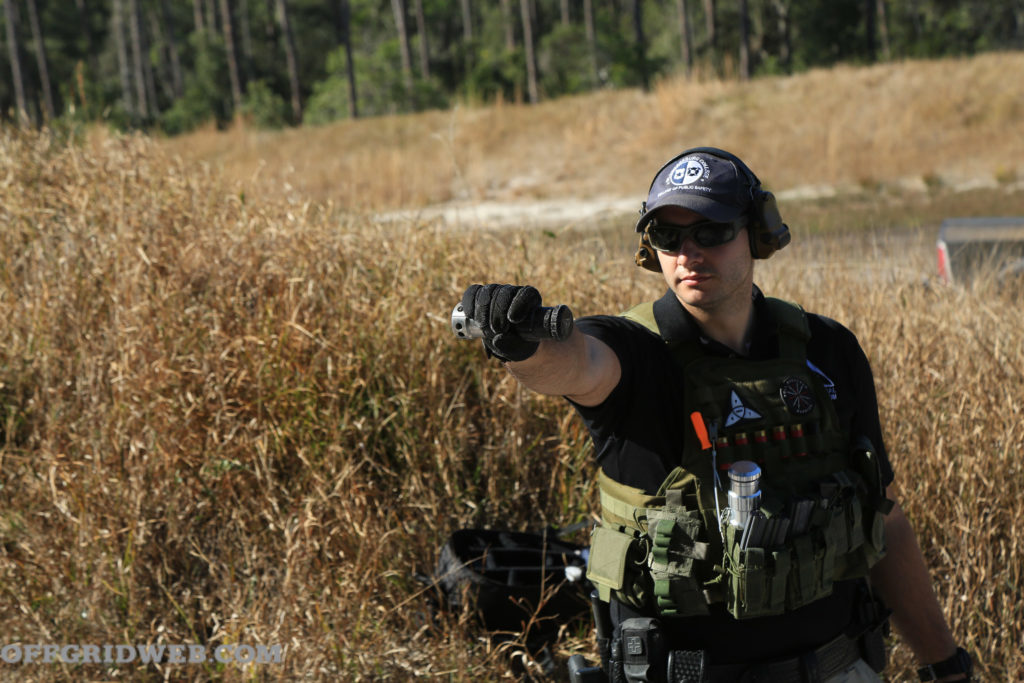 Above: The PAMAX Tactical LION is designed such that even dropping it right at your feet poses no risk of frag or direct injury. Just make sure you’ve got eyes and ears on.
Above: The PAMAX Tactical LION is designed such that even dropping it right at your feet poses no risk of frag or direct injury. Just make sure you’ve got eyes and ears on.
The issue that arises with all of these designs is that they rely on high-explosives, which are highly regulated by the BATFE. Civilian possession is extremely limited and comes with a whole host of required boxes to check, including specialized transportation and storage requirements.
These regulations, coupled with a “civilians don’t need this” perception of such devices, have made them essentially impossible to possess for anyone without agency or unit credentials. But a small company called PAMAX Tactical has come up with a solution that overcomes the legal hurdles, and has allowed us to more deeply ponder the question of “need” and application for lay persons in a defensive context. They’ve named their solution the LION BFD – Low Impact Ordnance Non-lethal, Blank Firing Device.
The PAMAX Tactical LION consists of a two-part design with a body and detachable base, of which there are two variants. The commercially available version uses a machined aluminum body and base. The body has a weighted, free-floating firing pin and a pull-ring safety block. Inserting the pin physically blocks the pin from impacting the blank. When the pin is pulled and the device is thrown, the floating weight is jarred on impact, causing the pin to punch the primer and detonate the device. The screw-on base has a pocket and removable adapter. The adapter has two different holes, one on each end, that can accommodate either a .209 shotgun primer or a flat-face 9mm blank (crimp-nose blanks will not work). If you remove the adapter entirely, the pocket in the base will accept a 1-inch shotgun blank. The base also has vent holes at the bottom to vent the flash and bang when the device goes off.
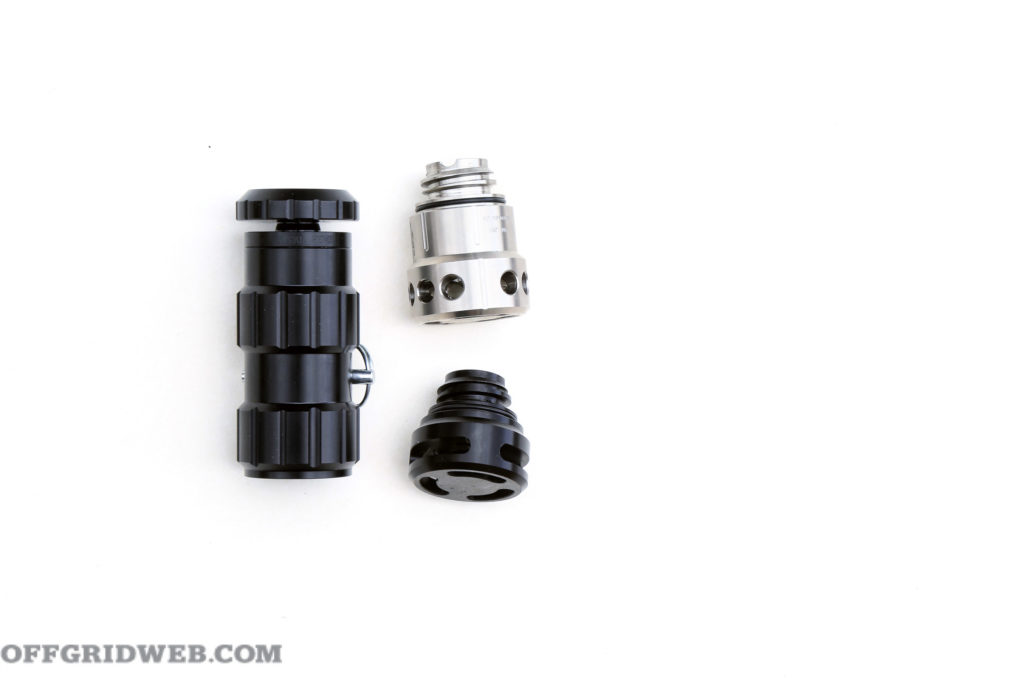 Above: The LION Blank Firing Device consists of a machined aluminum body with two detachable bases: aluminum for commercial use and a larger stainless steel one for law enforcement.
Above: The LION Blank Firing Device consists of a machined aluminum body with two detachable bases: aluminum for commercial use and a larger stainless steel one for law enforcement.
Building and labelling the PAMAX Tactical LION as a dedicated blank-firing device serves two purposes. First, it avoids any potential legal and liability issues from ATF, as it’s not intended to be a “grenade” of any kind. It also allows the end user a lot of flexibility to scale the intensity of detonation up and down based on use.
PAMAX does have a second thread-on base module for the LION body, which they call the V2. The V2 doesn’t have any additional adapters but is made of stainless steel and bored a little deeper to accommodate 2-inch shotgun blanks. Neither base will accommodate full-length 2¾-inch shells to eliminate the risk of inadvertently loading a buckshot round into the LION, which could make everyone in the room have a really bad day if thrown. But at time of writing, the V2 base is currently restricted as a law-enforcement-only item.
Our biggest concern with the V2 base being a restricted item, from a practical standpoint, is whether or not this will neuter the LION’s capabilities for commercial consumers and limit it to being a novelty item for paintball and airsoft games. But PAMAX Tactical tells us that they’re currently working with an ammo manufacturer to produce blank cartridges optimized for the LION that’ll feature charge levels and powder mixtures calculated to wring every ounce of pyrotechnic potential out of their product.
We had the chance to spend two days with the owners of PAMAX Tactical at the Deep Woods Ranch in Florida. Deep Woods is a private training facility run by former SEAL Rich Graham of Full Spectrum Warrior. Full Spectrum offers a variety of firearms training courses to civilians, law enforcement, and allied partner nations. The ranch features several shooting ranges and enclosed structures perfect for torture testing the LION. We ran tests indoors and outdoors, in barn stalls and shipping containers, with multiple different types of primers and blanks, including black powder blanks. The central Florida sugar sand was just what we needed to get the LION moist, dirty, and crusty to test the firing mechanism and safety features.
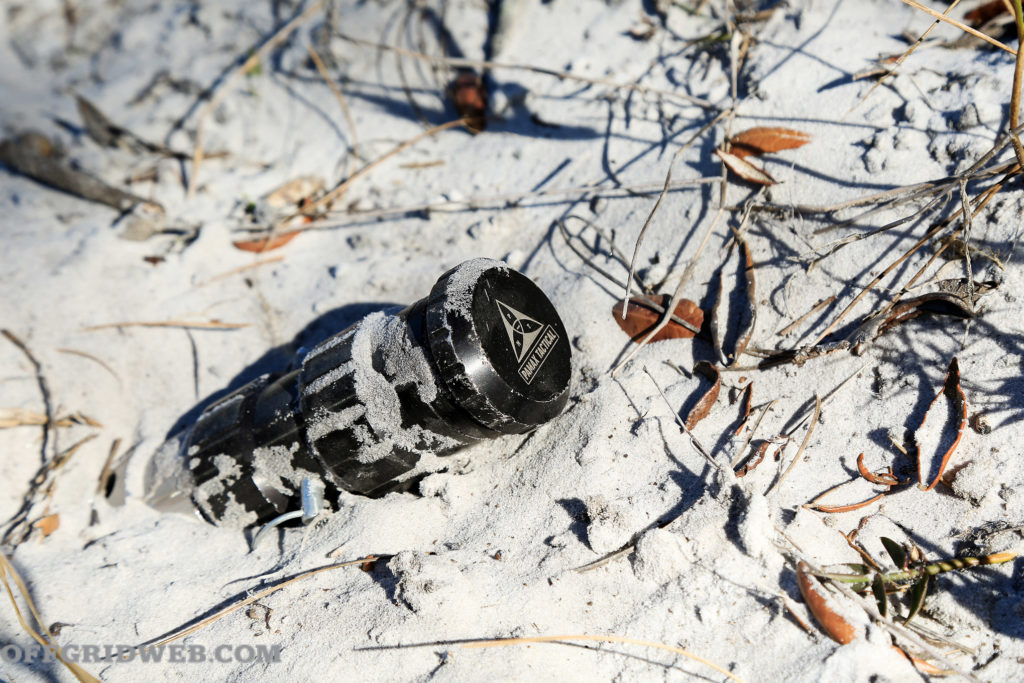 Above: Even when we actively packed it with wet Florida “sugar sand,” the LION functioned with 100-percent reliability.
Above: Even when we actively packed it with wet Florida “sugar sand,” the LION functioned with 100-percent reliability.
We started with .209 primers, which produced only a token pop. Inflating a brown paper bag and popping it is probably louder. Our initial reaction was somewhere in the realm of “What’s the point of this?” until an interesting scenario was put forth: using a LION with primers to train military and law-enforcements K9s who are attached to entry teams. Primers are cheap, LIONs are reloadable, and the pop is enough to get dogs used to working around hand-thrown munitions without the cost and hearing risk to the dog associated with using full-power flash-bangs. We’ll see if someone else comes to that same conclusion, but it certainly adds to the potential versatility of this product.
Next up was testing 9mm blanks. In a confined space, it’s enough to get your attention if you’re scrolling through your phone, tuned out to the world. But it’s hardly what we’d call overwhelming. This might be a good option for paintballers and milsim reenactors who want to simulate that “bang out!” moment from Call of Duty while making entry without blowing out any eardrums.
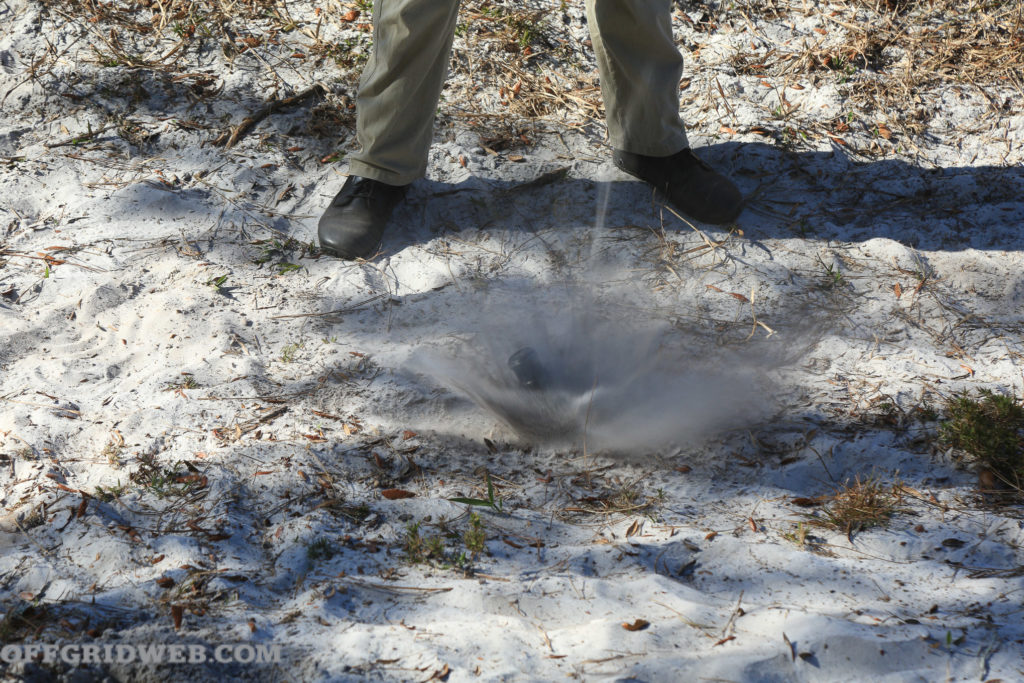
Loading the LION with 1-inch shotgun blanks is where things started to get interesting. The results weren’t enough to produce sensory overload, but unsuspecting recipients in a small room are likely to at least suffer a distraction/startle response. Is that enough capability to store one in a go-bag? We’ll get to that in a minute …
Finally, we swapped to the V2 base and ran a variety of 2-inch shotgun blanks. The author volunteered to stand inside a dark, open room with a concrete floor while the PAMAX Tactical LION was thrown in repeatedly with different loads. My level of distraction/confusion was largely nullified by context: I knew it was coming and watched the reps from PAMAX launching this thing at me. Having said that, several of the 2-inch blanks produced a flash bright enough to leave me seeing polka dots, and one of the loads produced enough overpressure that I definitely felt the “thump” of overpressure inside my rib cage when the LION detonated. Does it match up to the intensity of an actual flash-bang or stun grenade? No. But the energy disparity between blanks and high explosive charges is significant. We hope PAMAX is able to close that gap with some purpose-built loads made especially for their device.
In terms of deploying the device, the PAMAX Tactical LION is as easy to use as the oversized safety crayons we get at chain restaurants with paper place mats, whenever we ask for chicken nuggets and apple slices. Load your blank or primer of choice into the base, screw the base onto the body, pull the safety pin, and throw. We literally packed the vent holes with wet sand before throwing and the LION never choked. We threw it on concrete floors and against every part of a vehicle we could hit: windows, windshields, hoods, wheels, and body panels. We only found one issue and one idiosyncrasy with it.
 Above: Depending on the size and type of blank used, the LION is capable of producing significant flash and moderate concussion.
Above: Depending on the size and type of blank used, the LION is capable of producing significant flash and moderate concussion.
Because the device requires a jolt to make the weighted firing pin assembly wobble enough to punch the primer, if the impact surface flexes or cushions the landing impact it could result in a misfire. We noticed this primarily with pockets of soft, dry sand and hoods or body panels of vehicles, which will flex or dent when hit hard enough. In these instances, giving the PAMAX Tactical LION a hard overhand throw that makes it tumble end-over-end added enough force to cause detonation, even on softer surfaces. We could not, no matter how hard we threw it, get the device to go off in our hand or in mid-air by throwing it too hard. While a side-arm lob will be plenty on a hard surface, throwing the LION end-over-end seemed to give the best chance of successful firing on the widest array of surfaces.
The only mechanical issue we saw with the LION was the pull-pin safety. We handled several different LION bodies over the course of our testing and on all of them, the cross-pin that actually inserts into the body fit incredibly tight. On the sample LION we received for studio photos and personal testing, the pin is so tight that it actually had to be tapped in place with a hammer the first several times we removed it. Pulling it free to arm the device is the closest we’ve ever come to an active game of tug-of-war with ourselves. But PAMAX is aware of the issue and already looking at options to make the safety pin more user-friendly. (Our demo unit did eventually loosen up some.)
We expect production models will either have a different pin or slightly larger hole machined into the body to make this process easier. In the meantime, there’s an alternate way to render the PAMAX Tactical LION safe: Simply unscrew the base from the body by one half-turn. This creates enough clearance that the pin cannot make physical contact with the primer. In our field testing, we eventually stopped using the safety pin and simply left the base unscrewed by a half-turn. When ready to deploy, just tighten the base down and throw. So, even if your safety pin requires some break-in, you don’t have to risk an AD with a blank-firing device.
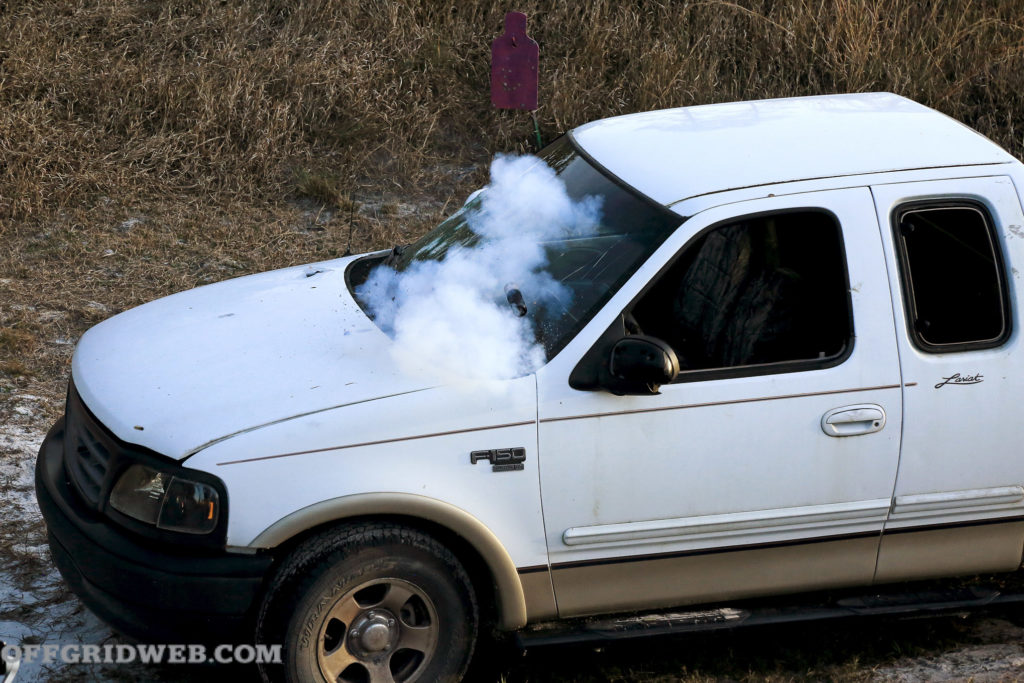 Above: With black powder blanks, the LION creates both smoke and sound diversion.
Above: With black powder blanks, the LION creates both smoke and sound diversion.
As a side note, PAMAX already has a couple of thoughtful accessories for the LION as well. They have a purpose-built Kydex holster available in MOLLE or belt-mount configurations, as well as two lanyards (polymer and braided wire) that can be looped through the safety pin and then attached to a hard point on the holster. The idea is that when you draw the LION out of the holster, the safety pin is pulled out along the way. But with the too-tight fitment we experienced, the pin (or pin hole) needs a little re-dimensioning for this to work as intended.
The burning question we had about the PAMAX Tactical LION BFD going into this evaluation was: “Is this applicable to civilians as a legitimate defensive or escape tool?”
The best answer we can come up with at this point is a hard, forehead-scrunching “maybe.”
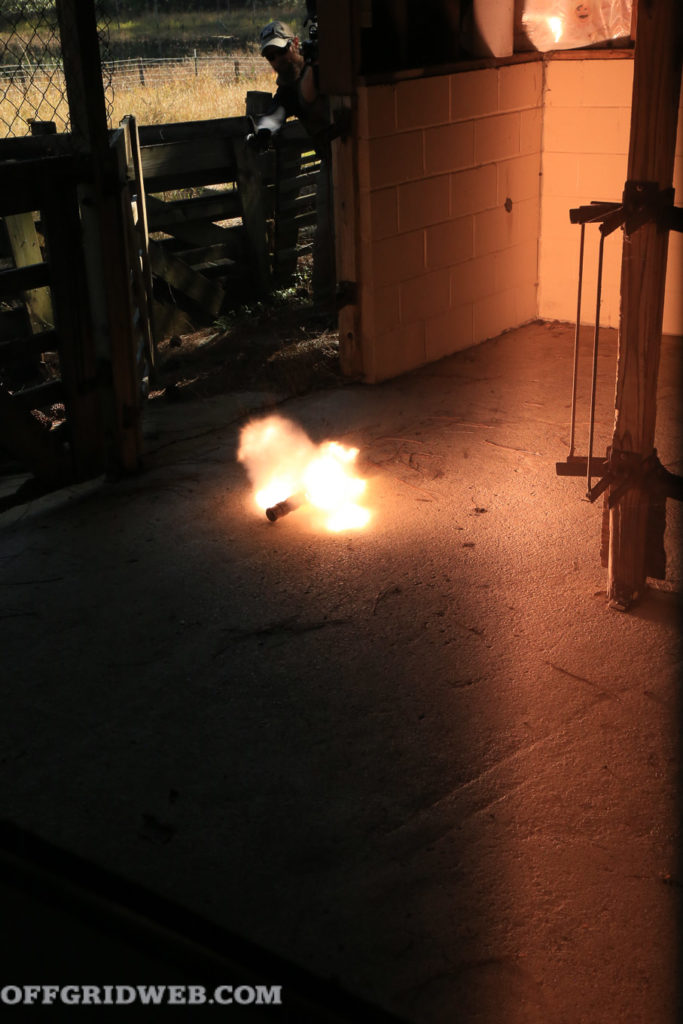
Our experience with preproduction samples using current commercially available blanks didn’t match anything we’ve ever felt when using true explosive-cored flash-bang grenades. That’s not to say it’s not capable of causing distraction or disorientation, but conditions will have to be ideal. Power factor aside, is there even a scenario where this could cause enough of a ruckus to allow you to escape or evade a bad situation? We came up with a couple scenarios where the LION could absolutely be useful, but also figured other solutions to those same problems.
> In your vehicle, being trapped/surrounded by a growing mob of agitated protestors. Could dropping a LION out your window cause a big enough bang to disperse the crowd? Possibly. But, if mistaken for a gunshot, it could also induce armed parties in the crowd to draw their guns and return fire, escalating the situation instead of breaking it up.
> In an active-shooter scenario, could tossing a PAMAX Tactical LION opposite your planned escape route distract a shooter or draw everyone’s attention, giving you a time advantage to make your escape? Possibly. If you have time to successfully deploy it.
> Something goes bump in the night in your living room. Could tossing a LION into the next room before making entry to confront the threat buy you some tactical advantage? Possibly. But we think you’d have to have received proper training in the specific tactics of making a room entry in conjunction with a distraction device. There’s also a possibility of disorienting yourself in the process, depending on room size, layout, and acoustics. Stealth might be your biggest ally, versus a dynamic one-man room entry — an incredibly dangerous prospect even for armed professionals. If you can evade or barricade while contacting the police, that would be the far more prudent option.
> Same scenario, in a setting where guns aren’t available, or perhaps where a family member who is uncomfortable with guns is alone. Could the LION scare off a potential home invader? If it does, great. If it doesn’t, you just exposed yourself while escalating the adrenaline level of everyone involved.
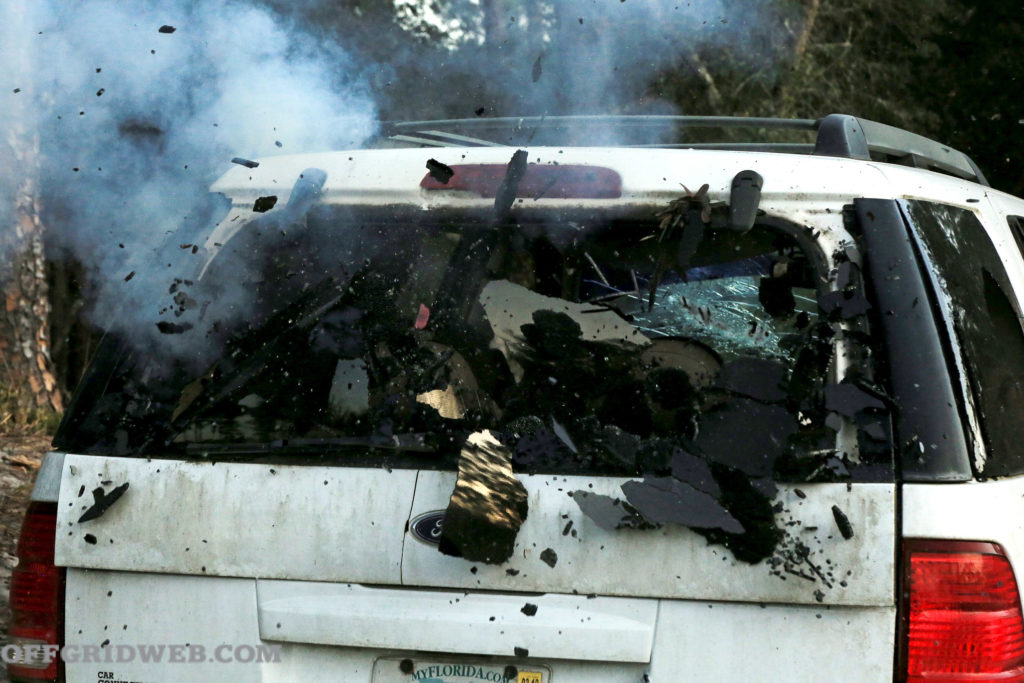 Above: We were able to use the LION to shatter this truck’s rear windshield but found that on flexible surfaces like safety glass and auto body panels, throwing technique was a factor for reliable detonation.
Above: We were able to use the LION to shatter this truck’s rear windshield but found that on flexible surfaces like safety glass and auto body panels, throwing technique was a factor for reliable detonation.
In the end, we’re a little hard-pressed to find a situation where the LION, or anything like it, would be the tool for the job in a self-defense context. But it’s a reasonable option to have accessible in a number of different scenarios. The proverbial “tool in the toolbox” to add one more capability to your emergency response spectrum. In addition to the reenactment/simulation value for those who want it, there’s also an opportunity for professional trainers to have a low-cost, low-risk way to introduce added stress to scenario-based training.
Regardless of what you want it for, an MSRP of $249 for body and base, plus the still-very-reasonable cost of blanks and primers, makes the PAMAX LION an affordable if not niche addition to any training toolbox.
PAMAX Tactical: pmtactical.com
Full Spectrum Warrior/Deep Woods Ranch: fullspectrumwarriors.com
 STAY SAFE: Download a Free copy of the OFFGRID Outbreak Issue
STAY SAFE: Download a Free copy of the OFFGRID Outbreak Issue
No Comments